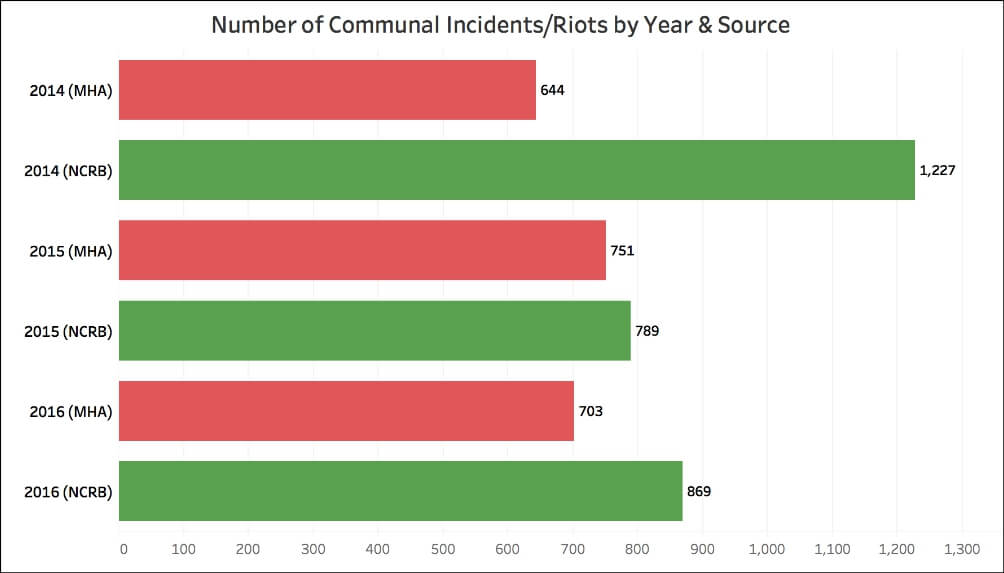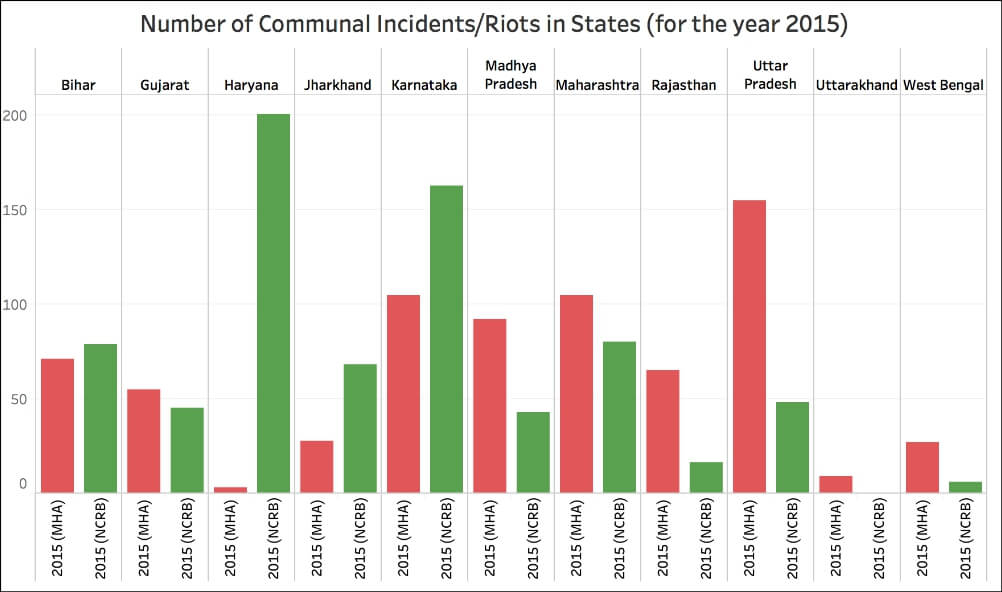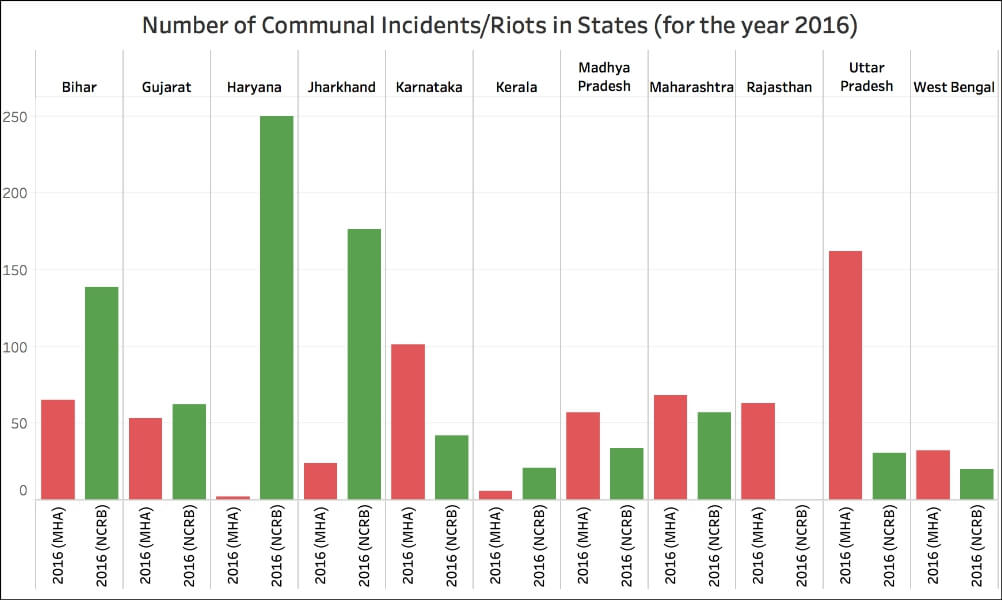[orc]The Crime in India report for the year 2016 is finally released by the NCRB. The report raises questions about the reliability of government data.
The National Crime Records Bureau (NCRB) has finally released the ‘Crime in India’ report for the year 2016. The data on communal incidents/riots from this report once again raises questions about the reliability of government’s crime data.
Factly was one of the first ones to report that the National Crime Records Bureau (NCRB) data on communal incidents/riots was not matching with the data provided by the Home Ministry for the year 2014. The trend continued in the year 2015 as well as 2016. A deeper analysis of state wise data from these two sources raises serious questions about the reliability of government data.
NCRB Data Collection on Riots
The National Crime Records Bureau (NCRB) is an attached office in the Ministry of Home Affairs (MHA). NCRB is tasked with collection and dissemination of a secure national database on crimes, criminals and law enforcement agencies etc. Every year, the NCRB collects data from Police departments at the state level and compiles it into a Crime in India report. The report has detailed information on various types of crimes.
In 2014, the NCRB has made significant changes to the method of its collection and dissemination of crime data. The template has been undergoing changes every year. The present template for collection of crime related data, has a section on riots as defined under Sections 147,148,149,150, 151 and 153A of the Indian Penal Code (IPC). There is also separate section to collect data on offences that promote enmity between different groups as defined under Sections 153A & 153B of the IPC.
There is also separate section to collect data on offences that promote enmity between different groups as defined under Sections 153A & 153B of the IPC. The template makes it clear that cases reported under Section 153A with other sections of riots (Section 147 to 151) should be shown in the category of riots whereas cases reported specifically under Sections 153A & 153B should be shown separately.
The template makes it clear that cases reported under Section 153A with other sections of riots (Section 147 to 151) should be shown in the category of riots whereas cases reported specifically under Sections 153A & 153B should be shown separately.
Before 2014, all the data related to riots used to be collected under one head called riots. From 2014, the data on riots is categorized into many different sub heads namely communal riots, Industrial riots and riots for political reasons etc. There is also a separate section on ‘Offences Promoting Enmity Between Different Groups’.
One has to remember that NCRB gets all the data from state police departments. And this data is strictly based on the sections mentioned in the First Information Report (FIR) of the cases filed. The NCRB also follows the ‘Principal Offence Rule’ for counting of crime. Hence among many offences registered in a single case, only most heinous crime (maximum punishment) will be considered as counting unit, thereby representing one case. Sometimes it is also possible that multiple cases will be filed for a single incident.
NCRB Vs MHA – The discrepancy in data continues
The data on communal riots in the NCRB report does not match with the data shared by the Ministry of Home Affairs (MHA) in the Lok Sabha. For the year 2014, NCRB reported almost twice the number of incidents compared to the number released by MHA. The gap closed in 2015 and again widened in 2016. In 2016, the NCRB reported 869 cases relating to communal riots compared to 703 communal incidents reported by the MHA. In addition, NCRB reported 336 cases relating to ‘Offences Promoting Enmity Between Different Groups’ in 2014 out of which 323 are offences for promoting enmity between groups based on religion, race etc. In the year 2015, the corresponding number of cases was 424 and 378. In 2016, a total of 478 cases relating to ‘Offences Promoting Enmity Between Different Groups’ were reported by NCRB out of which 447 were offences for promoting enmity between groups based on religion, race etc.
In addition, NCRB reported 336 cases relating to ‘Offences Promoting Enmity Between Different Groups’ in 2014 out of which 323 are offences for promoting enmity between groups based on religion, race etc. In the year 2015, the corresponding number of cases was 424 and 378. In 2016, a total of 478 cases relating to ‘Offences Promoting Enmity Between Different Groups’ were reported by NCRB out of which 447 were offences for promoting enmity between groups based on religion, race etc.
If the number of cases relating to communal riots and cases relating to promoting enmity between groups from the NCRB report are added, then the difference between the NCRB data & MHA data widens further.
What is the Government’s explanation?
The government on multiple occasions maintained that (NCRB) collects police registered communal riots cases (FIRs) from States and there could be multiple FIRs in a single incident of communal violence and hence NCRB data may be different compared to MHA data which is communal incidents based but not FIR based.
Why Government’s explanation is not plausible
As per the government’s explanation, the NCRB numbers should be higher for each state since they are based on FIRs in police stations and that there could be multiple FIRs for a single incident. Even if this is believed to be true, the difference or the trend should be uniform across states.
For the year 2014, there was a discrepancy between the numbers reported by NCRB & MHA for as many as 23 States/UTs. Strangely, in states like Haryana, Jharkhand, Tamil Nadu and West Bengal, the numbers reported by NCRB were way higher than the ones reported by MHA whereas in states like Karnataka, Madhya Pradesh, Rajasthan, Gujarat & Uttar Pradesh, the MHA numbers were higher than those reported by NCRB.
In the case of Uttar Pradesh in 2014, the MHA reported 133 incidents while NCRB only reported 51 communal riot cases. The NCRB report also reported 26 cases of promoting enmity between groups in Uttar Pradesh. Together,both the numbers make up for only 77 such cases by the NCRB while the MHA reported 133 such incidents.
This trend repeated in 2015 where the discrepancy was observed in as many as 24 States/UTs. In 2016, the discrepancy observed in 25 States/UTs. In both these years, the difference in the numbers was mixed with some states showing a higher number as per MHA and some other states showing up a higher number as per NCRB. For the state of Rajasthan in 2016, the MHA reported 63 communal incidents. In the same year, the NCRB did not report a single case of communal riot in Rajasthan while it reported only 22 cases of promoting enmity between groups.
For the state of Rajasthan in 2016, the MHA reported 63 communal incidents. In the same year, the NCRB did not report a single case of communal riot in Rajasthan while it reported only 22 cases of promoting enmity between groups.
The larger question about reliability of Government data
In all probability, the MHA may also be getting data on communal incidents from the state police. In such a case, a lower number in NCRB data for a particular state clearly indicates that cases were not filed in some instances of communal incidents. The discrepancy raises the following larger questions.
- Why are state police departments not filing a FIR in each & every incident that is communal in nature?
- Why are the MHA and NCRB not sitting together to reconcile their respective data and use it for better functioning of the police?
As seen for various years from 2014 to 2016, the reasons mentioned by the government for data discrepancy do not add up, thus raising the larger question about the reliability of government data in general and crime data in specific.



2 Comments
Great work Factly! I always thought it would only be a matter of time before this government gets to the manipulation of data stage. Now they have done it.
Pingback: The intriguing case of data on ‘Communal Incidents’ in India - Fact Checking Tools | Factbase.us